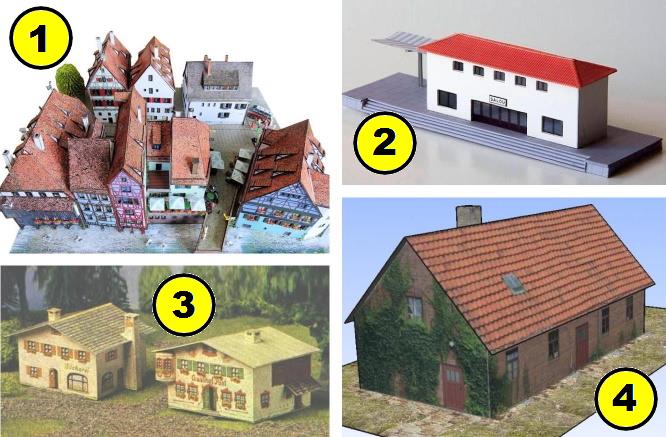This is the "Cordonnerie," or the Shoemaker's Shop, a paper model in HO scale (1/87) that is part of La Petite Cité (The Little Town), a great collection of architectural papercrafts created by French designer Jean-Pierre Larouzé from the website Decoupages Faciles.
Perfect for railway layouts, dioramas, and wargames, the entire model fits on just one sheet of paper.
You can make it more detailed by printing several sheets and using the slicing and gluing method to achieve a 3D effect.
Note: The template presented in the fourth image of this post is a low-resolution reproduction and is for illustrative purposes only. Please visit Mr. Larouzé's website to download the high-resolution templates, ok?
Since the rustic architecture and the sign resemble buildings common in France during the Second World War, I tried to find out what a typical shoe shop in a French village would be like at that time, and what I found was that these small commercial buildings were simple but full of charm.
They often displayed wooden or metal signs with the name of the shop, or, as in the case of our shoemaker's shop, the name painted directly onto the facade in a handcrafted manner. The letter style was almost always traditional, with simple, direct typography.
With modest wooden and glass facades, many had a small window showcasing just a few pairs of shoes.
The interior, cozy and functional, had wooden shelves and a workbench where cobblers repaired and made custom shoes.
The cobbler’s work area was visible, with a wooden workbench, hammers, nails, glue, and other tools necessary for making and repairing shoes. There might have been a small oven for warming glue or softening leather.
As the war affected large industries and trade, shoemaker's shops in villages likely had a loyal clientele and a constant flow of work due to the need for frequent repairs.
With material shortages, shoes were often made from simpler leather or even fabric, as rationing made it difficult to produce high-quality materials.
Repairs were common, with the local clientele often opting to fix their shoes rather than buy new ones.
The shoemaker’s shop was an essential space in the village, providing not only products but also services necessary for survival during hard times.
Esta é a "Cordonnerie", ou a Sapataria, um modelo de papel na escala HO (escala 1/87) que faz parte de La Petite Cite (A Pequena Cidade), uma coleção bem bacana de papercrafts arquitetônicos criada pelo designer francês Jean-Pierre Larouzé, do site Decoupages Faciles.
Perfeito para maquetes ferroviárias, dioramas e wargames, o modelo todo ocupa apenas uma folha de papel e você pode torná-lo mais detalhado imprimindo várias folhas e usando o método do fatiamento e colagem de peça sobre peça para conseguir um efeito 3D.
Atenção: a imagem abaixo está em baixa resolução e é meramente ilustrativa. Visite o site do Sr. Larouzé para baixar os templates em alta resolução, ok?
Como a arquitetura rústica e o letreiro remetem a construções comuns na França na época da Segunda Grande Guerra, eu procurei saber como seria uma típica sapataria de um vilarejo francês nessa época e o que descobri foi que essas casas comerciais eram simples, mas cheias de charme.
Elas costumavam ostentar cartazes de madeira ou metal com o nome da loja, ou, como no caso da nossa sapataria, pintada diretamente na fachada, de forma artesanal. O estilo das letras era quase sempre tradicional, com uma tipografia simples e direta.
Com fachadas modestas de madeira e vidro, muitas tinham uma vitrine com poucos pares de sapatos expostos.
O interior, aconchegante e funcional, possuía prateleiras de madeira e uma bancada onde os sapateiros faziam reparos e confeccionavam sapatos sob medida.
A área de trabalho do sapateiro ficava visível, com uma bancada de madeira, martelos, pregos, cola, e outros utensílios necessários para fazer e reparar sapatos. Talvez houvesse um forno pequeno para aquecer a cola ou amolecer o couro.
Como a guerra afetou as grandes indústrias e o comércio, as sapatarias em vilas provavelmente tinham uma clientela fiel e um fluxo constante de trabalho, devido à necessidade de reparos frequentes.
Com a escassez de materiais, os sapatos eram frequentemente feitos de couro mais simples ou até tecidos, já que o racionamento dificultava a produção com materiais de alta qualidade.
Reparos eram comuns, com a clientela local frequentemente buscando consertar seus calçados em vez de comprar novos.
A sapataria era um espaço essencial no vilarejo, proporcionando não apenas produtos, mas também serviços necessários para a sobrevivência durante tempos difíceis.
Link: Small.French.Shoemaking.Shop.Paper.Model.In.HO.Scale.by.Jean.Pierre.Larouzé
More Architectural Paper Models created by Jean-Pierre Larouzé related posts:
































